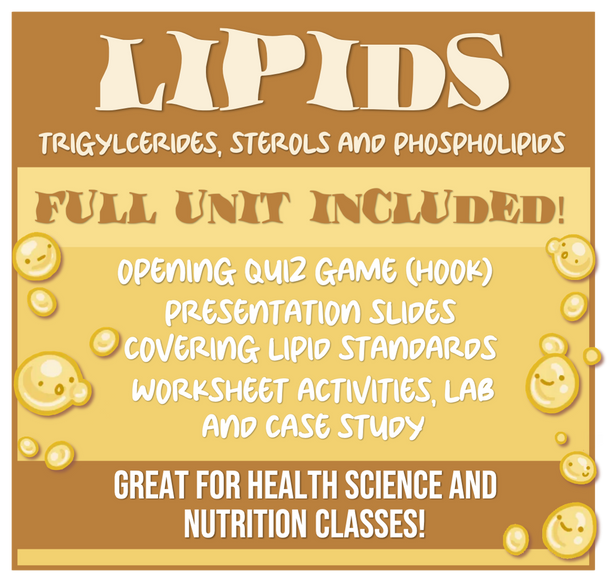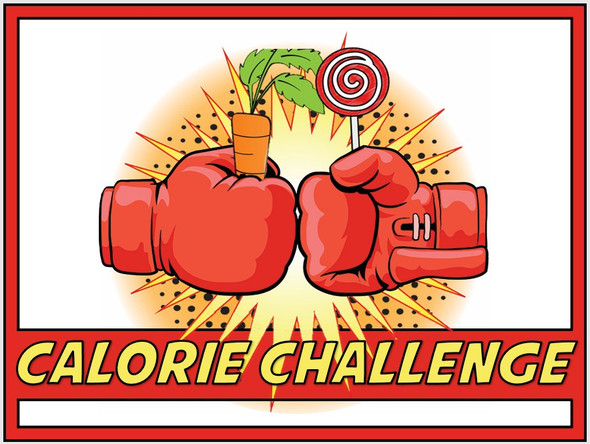Description
The unit on lipids is a vital component of teaching nutrition. As one of the 3 major macronutrients and the one that is closely tied to many medical conditions and diseases, it stands to hold significant importance. This unit is very large, but I included plenty of supporting activities and worksheets that are completely optional. I have also included both written and video instructions for you to use to help you execute the lesson confidently.
I will briefly go through and describe each of the items included. However, if you have any questions on further clarification, feel free to reach out. I've also included a preview of the documents included (see "preview").
In this unit you will receive the following resources:
“Fat Chance” Game:
Presented as a PPT or Google Slides Presentation- comes with PDF Student handout as a printable or fillable version
This is a game I like to play at the beginning of this unit. I use it as my “hook” and it is used to help the students get prepared for the unit on Lipids. It is set up as a “quiz show” style game but has a few extra rules that allow students to double-down on their guesses. All of the questions were designed to not need any prior knowledge. Instead, they will use their reasoning skills (and a little luck) to make educated guesses.
“Lipids Presentation” and Student Notes Page:
Presentation comes as a PPT or Google Slides presentation.Student notes page is a printable or fillable PDF.Answer Key included.
This is the “meat” of the lesson where I have taken all of the major standards for the Lipids unit and made it into a colorful and easy to present lecture. There are built in quiz questions and it is designed to be presented in a paced style with supporting worksheets and activities.
Topics include:
-
Overview of lipids
-
Function of lipids
-
Types of lipids
-
Overview and biochemistry of triglycerides
-
Length of Chain
-
Types of triglycerides (sat vs unset)
-
Overview and biochemistry of sat and unsat fats
-
Types of unsaturated fats (MUFA and PUFAS- including omegas)
-
Listing of most common sat and unsat fats
-
Cis vs Trans fats
-
Science of trans fats
-
Phospholipid overview and biochemistry
-
Sterol overview and biochemistry
-
Digestion of lipids
-
Absorption of lipids (including micelles and lipoproteins)
The notes page was created for students to use and fill in the blanks. This can be helpful for pacing as well as keeping students on task.
“Lipid Family Tree”:
Comes as a printable or fillable PDF- answer key included
This is a tool I use for all of my macro units to help students organize the “branches” and categories of lipids. It can be overwhelming to keep up with each of the types of lipids and I have found this useful in helping to fully understand and comprehend.
“Color Coded Fats”:
Comes as a printable PDF- answer key included
In teaching nutrition, it is easy to get caught up in the bio-chemistry of it all and forget to help make a connection to the “real world.” I created this activity to help make that connection. Students will research the food items listed and then color code them based on whether they are predominantly saturated or unsaturated fats.
“Show Me What You Are Made Of”:
Comes as a printable PDF- answer key included
Going a step further, this worksheet allows students to break down various oils to show their composition of saturated, poly-unsaturated and mono-unsaturated fats. This is a great place to also allow students to utilize math skills since they will need to find the percentage breakdown of each fat and then chart the results.
“Find the Fat” Lab:
Step-by-step student instructions as a PPT or Google slides presentation.Handout comes as a printable PDF- detailed teacher instructions included
I think having a hands-on activity is very important and this is one of my favorite labs to perform. Using various foods, students will create a hypothesis on which foods contain the most fat. Then utilizing brown paper bags, they will be able to visually confirm the answers. Because fat does not evaporate at room temperature, the more fat in an item, the larger a stain will be left behind. This brown paper fat lab is a great way to connect their learning with real-world examples.
The lab includes a student handout, a Powerpoint (or Google Slides presentation) to follow along with as well as a very detailed instruction page for the teacher. The presentation will guide your students through the lab. This lab requires various food items (ideas included in instruction guide), scissors, markers, paper plates and brown paper sandwich bags.
“Name That Fatty Acid” Activity:
Present activity as a PPT or Google slides presentation.Handout and flashcards come as a printable PDF-answer key included
This activity is totally optional but I do enjoy teaching the students how to create the numeric expression and line-angle formula for the fatty acids we have been talking about. Most of the students have seen these concepts in their chemistry classes, but I also know that this is something that is taught at the collegiate level so I think it is important to cover if there is time.
The first step is to have students create their “flashcards.” This will help them at identifying the fatty acid once the numeric expression is confirmed. Once the flashcards are created, you can either allow them to fill out the worksheet provided or have them fill it out using the presentation.
“Lipids and Disease” Presentation:
Presentation comes as a PPT or Google Slides Presentation
I know that a lot of standards require the connection between health and the macro. I created this short presentation to basically sum up what the most current research is saying about fats as well as the most current recommendations.
“Recipe Renovation” worksheet:
.Handout comes as a printable PDF- answer key included
Health and nutrition should always go hand in hand and this activity is a great way to connect the two. I always have my students take the information they learned and utilize it to modify a recipe. I tell them to think as if they are nutritionists helping a patient with a disease or condition. In this scenario, the patient has hypercholesterolemia and they must modify a brownie recipe to make it more heart healthy.
*I was able to convert all but one of the PowerPoint presentations into a Google Slide presentation, however, there are some differences in the two upon conversion. Most of the visual effects did not transfer, but overall the appearances are very similar.
This lesson typically takes me 7-9 class days to complete if I do all of the activities included. I tried to provide as much detail as possible in the description, however, if you have questions don't hesitate to reach out!












